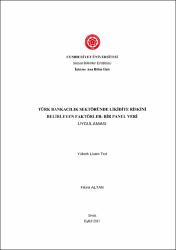| dc.contributor.advisor | Demir, Mehmet | |
| dc.contributor.author | Altan, Fikret | |
| dc.date.accessioned | 2021-12-30T11:13:03Z | |
| dc.date.available | 2021-12-30T11:13:03Z | |
| dc.date.issued | 2017 | tr |
| dc.date.submitted | 2017-08-05 | |
| dc.identifier.other | xi, 119 sayfa | |
| dc.identifier.uri | https://hdl.handle.net/20.500.12418/12432 | |
| dc.description.abstract | Kısaca, bankanın yükümlülüklerini yerine getirecek düzeyde likiditeye
sahip olmaması şeklinde tanımlanan likidite riski, bankacılık sektörüne özgü
önemli risklerden biridir. Finansal sistemde yer alan yatırımcılar ve tasarruf
sahiplerini bir araya getirmede finansal aracılık fonksiyonunu icra eden bankaların
bu yönde yaşayacakları bir risk veya kriz durumu reel kesimi de olumsuz
etkileyecektir. Dolayısıyla likidite riskinin etkin bir şekilde yönetilmemesi, mikro
açıdan bankacılık sektörünü makro açıdan ise ülkenin ekonomik gelişimini
engelleyecektir.
Bu çalışmanın amacı, Türk bankacılık sektöründe faaliyet gösteren
mevduat bankalarının likidite riskini belirleyen faktörleri araştırmaktır. Bu
bağlamda, 2009-2014 yıllarını kapsayan dönemde Türk bankacılık sektöründe
faaliyet gösteren 28 mevduat bankasının yıllık verileri elde edilmiş ve likidite
riski yönetiminde etkili olan faktörler statik ve dinamik panel veri regresyon
yöntemi ile test edilmiştir. Likidite riski modelinin tahmin edilmesinde
Havuzlanmış En Küçük Kareler (EKK), Tesadüfi Etkiler ve Sabit Etkiler gibi
geleneksel statik panel veri yöntemlerinin yanı sıra sistem iki aşamalı
genelleştirilmiş momentler metodu da (GMM) kullanılmıştır. Statik panel veri
tahmin yöntemlerinin içsellik sorununu dikkate almaması nedeniyle likidite riski
modelinin yorumlanmasında değişkenlerin içsel olma durumlarını da göz önünde
bulunduran sistem GMM tahmincisi kullanılmıştır. Bu model ile elde edilen
bulgulardan hareketle gecikmeli likidite, mevduat oranı, alınan krediler ve varlık
kârlılığı gibi değişkenler ile likidite riski değişkeni arasında pozitif ve anlamlı bir
ilişki olduğu bulgularına ulaşılmıştır. Buna karşılık, banka büyüklüğü ile likidite
riski arasında negatif ve anlamlı bir ilişki olduğu da tespit edilmiştir. Ayrıca,
banka sermayesi, takipteki krediler, özkaynak kârlılığı, faiz dışı gelirler ve faiz
marjı değişkenleri ile likidite riski arasında istatistiksel olarak anlamlı sonuçlar
bulunamamıştır. | tr |
| dc.description.abstract | In short, the liquidity risk, defined as not having enough liquidity to meet
the obligations of the bank, is one of the important risks peculiar to the banking
sector. A risk or crisis situation experienced by Banks that implement the
financial intermediation function by bringing together investors and savers in the
financial system will have a negative impact on the real sector. Therefore, the fact
that the liquidity risk is not effectively managed will hamper both the banking
sector and country's economic growth from a micro-and-macro perspective.
The purpose of this study is to investigate the determinants of the liquidity
risk of deposit banks operating in the Turkish banking sector. In this context, the
annual data of 28 deposit banks operating in the Turkish banking sector in the
period covering 2009-2014 are obtained and the factors affecting liquidity risk
management are tested by static and dynamic panel data regression method. When
estimating the liquidity risk model, the two-step generalized method of moments
(GMM), as well as traditional static panel data methods such as Pooled Ordinary
Least Squares (POLS), Random Effects (RE) and Fixed effects (FE) are
employed. Because of the fact that the static panel data estimation methods (i.e.,
POLS, RE, and FE) do not take into account the problem of endogeneity, the
results obtained from the system GMM estimator considering endogeneity of
variables is used in interpreting of liquidity risk model. The findings from this
model indicate that there are positive and significant relationships between
variables such as lagged liquidity, deposit level, credits received and asset
profitability, and liquidity risk variable. On the other hand, it is also found that
there is a negative and significant linkage between bank size and liquidity risk.
Furthermore, there are no statistically significant associations between the bank
capital, non-performing loans, return on equity, noninterest income and interest
margin variables and liquidity risk. | tr |
| dc.language.iso | tur | tr |
| dc.publisher | Sivas Cumhuriyet Üniversitesi-Sosyal Bilimler Enstitüsü | tr |
| dc.rights | info:eu-repo/semantics/openAccess | tr |
| dc.subject | Likidite Riski | tr |
| dc.subject | Panel Veri Analizi | tr |
| dc.subject | Bankacılık Sektörü | tr |
| dc.subject | Türkiye | tr |
| dc.subject | Sistem GMM | tr |
| dc.title | Türk Bankacılık Sektöründe Likidite Riskini Belirleyen Faktörler: Bir Panel Veri Uygulaması | tr |
| dc.type | masterThesis | tr |
| dc.contributor.department | Sosyal Bilimler Enstitüsü | tr |
| dc.relation.publicationcategory | Tez | tr |















